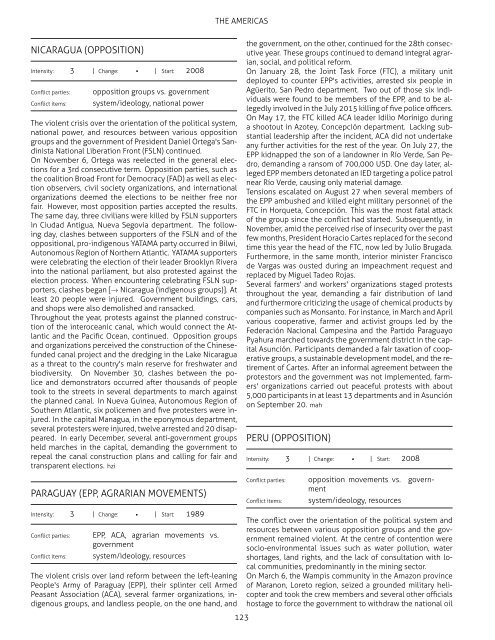ConflictBarometer_2016
ConflictBarometer_2016
ConflictBarometer_2016
Create successful ePaper yourself
Turn your PDF publications into a flip-book with our unique Google optimized e-Paper software.
THE AMERICAS<br />
NICARAGUA (OPPOSITION)<br />
Intensity: 3 | Change: | Start: 2008<br />
Conflict parties:<br />
Conflict items:<br />
opposition groups vs. government<br />
system/ideology, national power<br />
The violent crisis over the orientation of the political system,<br />
national power, and resources between various opposition<br />
groups and the government of President Daniel Ortega's Sandinista<br />
National Liberation Front (FSLN) continued.<br />
On November 6, Ortega was reelected in the general elections<br />
for a 3rd consecutive term. Opposition parties, such as<br />
the coalition Broad Front for Democracy (FAD) as well as election<br />
observers, civil society organizations, and international<br />
organizations deemed the elections to be neither free nor<br />
fair. However, most opposition parties accepted the results.<br />
The same day, three civilians were killed by FSLN supporters<br />
in Ciudad Antigua, Nueva Segovia department. The following<br />
day, clashes between supporters of the FSLN and of the<br />
oppositional, pro-indigenous YATAMA party occurred in Bilwi,<br />
Autonomous Region of Northern Atlantic. YATAMA supporters<br />
were celebrating the election of their leader Brooklyn Rivera<br />
into the national parliament, but also protested against the<br />
election process. When encountering celebrating FSLN supporters,<br />
clashes began [→ Nicaragua (indigenous groups)]. At<br />
least 20 people were injured. Government buildings, cars,<br />
and shops were also demolished and ransacked.<br />
Throughout the year, protests against the planned construction<br />
of the interoceanic canal, which would connect the Atlantic<br />
and the Pacific Ocean, continued. Opposition groups<br />
and organizations perceived the construction of the Chinesefunded<br />
canal project and the dredging in the Lake Nicaragua<br />
as a threat to the country's main reserve for freshwater and<br />
biodiversity. On November 30, clashes between the police<br />
and demonstrators occurred after thousands of people<br />
took to the streets in several departments to march against<br />
the planned canal. In Nueva Guinea, Autonomous Region of<br />
Southern Atlantic, six policemen and five protesters were injured.<br />
In the capital Managua, in the eponymous department,<br />
several protesters were injured, twelve arrested and 20 disappeared.<br />
In early December, several anti-government groups<br />
held marches in the capital, demanding the government to<br />
repeal the canal construction plans and calling for fair and<br />
transparent elections. hzi<br />
PARAGUAY (EPP, AGRARIAN MOVEMENTS)<br />
Intensity: 3 | Change: | Start: 1989<br />
Conflict parties:<br />
Conflict items:<br />
EPP, ACA, agrarian movements vs.<br />
government<br />
system/ideology, resources<br />
The violent crisis over land reform between the left-leaning<br />
People's Army of Paraguay (EPP), their splinter cell Armed<br />
Peasant Association (ACA), several farmer organizations, indigenous<br />
groups, and landless people, on the one hand, and<br />
123<br />
the government, on the other, continued for the 28th consecutive<br />
year. These groups continued to demand integral agrarian,<br />
social, and political reform.<br />
On January 28, the Joint Task Force (FTC), a military unit<br />
deployed to counter EPP's activities, arrested six people in<br />
Agüerito, San Pedro department. Two out of those six individuals<br />
were found to be members of the EPP, and to be allegedly<br />
involved in the July 2015 killing of five police officers.<br />
On May 17, the FTC killed ACA leader Idilio Morínigo during<br />
a shootout in Azotey, Concepción department. Lacking substantial<br />
leadership after the incident, ACA did not undertake<br />
any further activities for the rest of the year. On July 27, the<br />
EPP kidnapped the son of a landowner in Río Verde, San Pedro,<br />
demanding a ransom of 700,000 USD. One day later, alleged<br />
EPP members detonated an IED targeting a police patrol<br />
near Río Verde, causing only material damage.<br />
Tensions escalated on August 27 when several members of<br />
the EPP ambushed and killed eight military personnel of the<br />
FTC in Horqueta, Concepción. This was the most fatal attack<br />
of the group since the conflict had started. Subsequently, in<br />
November, amid the perceived rise of insecurity over the past<br />
few months, President Horacio Cartes replaced for the second<br />
time this year the head of the FTC, now led by Julio Brugada.<br />
Furthermore, in the same month, interior minister Francisco<br />
de Vargas was ousted during an impeachment request and<br />
replaced by Miguel Tadeo Rojas.<br />
Several farmers' and workers' organizations staged protests<br />
throughout the year, demanding a fair distribution of land<br />
and furthermore criticizing the usage of chemical products by<br />
companies such as Monsanto. For instance, in March and April<br />
various cooperative, farmer and activist groups led by the<br />
Federación Nacional Campesina and the Partido Paraguayo<br />
Pyahura marched towards the government district in the capital<br />
Asunción. Participants demanded a fair taxation of cooperative<br />
groups, a sustainable development model, and the retirement<br />
of Cartes. After an informal agreement between the<br />
protestors and the government was not implemented, farmers'<br />
organizations carried out peaceful protests with about<br />
5,000 participants in at least 13 departments and in Asunción<br />
on September 20. mah<br />
PERU (OPPOSITION)<br />
Intensity: 3 | Change: | Start: 2008<br />
Conflict parties: opposition movements vs. government<br />
Conflict items:<br />
system/ideology, resources<br />
The conflict over the orientation of the political system and<br />
resources between various opposition groups and the government<br />
remained violent. At the centre of contention were<br />
socio-environmental issues such as water pollution, water<br />
shortages, land rights, and the lack of consultation with local<br />
communities, predominantly in the mining sector.<br />
On March 6, the Wampis community in the Amazon province<br />
of Maranon, Loreto region, seized a grounded military helicopter<br />
and took the crew members and several other officials<br />
hostage to force the government to withdraw the national oil


